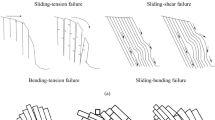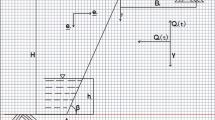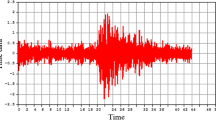Abstract
Currently, scant attention has been paid to the theoretical analysis on dynamic response mechanism of the “Dualistic” structure rock slope. The analysis presented here provides insight into the dynamic response of the “Dualistic” structure rock slope. By investigating the principle of energy distribution, it is shown that the effect of a joint plays a significant role in slope stability analysis. A dynamic reflection and transmission model (RTM) for the “Dualistic” structure rock slope and explicit dynamic equations are established to analyze the dynamic response of a slope, based on the theory of elastic mechanics and the principle of seismic wave propagation. The theoretical simulation solutions show that the dynamic response of the “Dualistic” structure rock slope (soft-hard) model is greater than that of the “Dualistic” structure rock slope (hard-soft) model, especially in the slope crest. The magnifying effect of rigid foundation on the dynamic response is more obvious than that of soft foundation. With the amplitude increasing, the cracks could be found in the right slope (soft-hard) crest. The crest failure is firstly observed in the right slope (soft-hard) during the experimental process. The reliability of theoretical model is also investigated by experiment analysis. The conclusions derived in this paper could also be used in future evaluations of Multi-layer rock slopes.
Similar content being viewed by others
References
Baker R, Shukha R, Operstein V, Frydman S (2006) Stability charts for pseudo-static slope stability analysis. Soil Dynamic and Earthquake Engineering, 26:813–823. DOI: 10.1016/j.soildyn.2006.01.023
David K, Eefer K (2002) Investmenting Landslides Caused by Earth Quakes’ Historical Review. Surveys in Geophysics 3: 475–510.
Fan LM, Yan N, Li N (2006) Dynamic response model for thin soft interlayer considering interbedded reflecting waves. Chinese Journal of Rock Mechanics and Engineering 25(1): 88–92. (In Chinese)
Gulyayev VI, Ivanchenko GM (2006) Discontinuous wave interaction with interfaces between anisotropic elastic media. Int J Solids Struct 43:74–90. DOI: 10.1016/j.ijsolstr.2005.06.001
Hong YS, Chen RH, Wu CS, Chen JR (2005) Shaking table tests and stability analysis of steep nailed slopes. Canadian Geotechnical Journal 42:1264–1279. DOI: 10.1139/t05-055
Huang JC, Kao SJ, Hsu ML, Liu YA (2007) Influence of Specific Contributing Area algorithms on slope failure prediction in landslide modeling. Natural Hazards and Earth System Sciences 7: 781–792. DOI: 10.5194/nhess-7-781-2007
Huang RQ, Li WL (2008) Research on development and distribution rules of geohazards induced by WencChuan Earthquake on 12th May, 2008. Chinese Journal of Rock Mechanics and Engineering 27(12): 2585–2592. (In Chinese)
Ingles J, Darrozes J, Soula JC (2006) Effects of the vertical component of ground shaking on earthquake-induced landslide displacements using generalized Newmark analysis. Engineering Geology 86:134–147. DOI: 10.1016/j.enggeo.2006.02.018
Jiang T, Ma J, Xu B (2007) Dynamic analysis method of slope stability based on LURR theory. Chinese Journal of Rock Mechanics and Engineering 26: 626–631. (In Chinese)
Jing F, Shao W, Zhang LX, et al. (2002) A thin-layer element for simulation of static and dynamic characteristic of soft interlayer and its application. Engineering Mechanics 19(2): 36–40. (In Chinese)
Li JC, Ma GW (2009) Experimental study of stress wave propagation across a filled rock joint, International Journal of Rock Mechanics & Mining Sciences 46(3):471–478.
Li JC, Ma GW (2010) Analysis of Blast Wave Interaction with a Rock Joint. Rock Mechanics and Rock Engineering 43:777–787.
Li JC, Ma GW, Zhao J (2011) Stress wave interaction with a nonlinear and slippery rock joint, International Journal of Rock Mechanics & Mining Sciences 44:85–92.
Li N (1993) Wave Propagation Problem in the Jointed Rock Mass. Xi’an: Press of the Northwest university of Technology.
Li YX, Zhu ZM, Li BX, et al. (2011) Study on the transmission and reflection of stress waves across joints. International Journal of Rock Mechanics & Mining Sciences 1:1–8.
Lin ML, Wang KL (2006) Seismic slope behavior in a large-scale shaking table model test. Engineering Geology 86:118–133.
Liu HL, Feikang, Gao YF (2003) Time history analysis methods of slope seismic stability. Rock and Soil Mechanics 24(4):553–556. (In Chinese).
Loukidis D, Bandini P, Salgado R (2003) Stability of seismically loaded slopes using limit analysis. Geotechnique 53(5):463–479. DOI: 10.1680/geot.2003.53.5.463
Malkawi H, Hassen WF, Sarna SK (2001) A global search method for locating general slip surface using montecarlo techniques. Journal of Geotechnical and Geoenvironmental Engineering 127(8):688–698.
Newmark NM (1965) Effects of earthquakes on dams and embankments. Geotechnique 15(2):139–160. DOI: 10.1680/ geot.1965.15.2.139
Pan DG, Lou ML (2008) An approach to solve random seismic response of layered soil. Engineering Mechanics 25(3): 91–95.
Qi SW, Wu FQ, Liu CL, Ding YH (2004) Engineering geology analysis on stability of slope under earthquake. Chinese Journal of Rock Mechanics and Engineering 23: 2792–2797. (In Chinese)
Seed HB (1979) Considerations in the earthquake-resistant design of earth and rockfill dams. Geotechnique 29(3):215–223. DOI: 10.1680/geot.1979.29.3.215
Tang HX, Shao LT (2004) Finite element analysis on slope stability of earth-rock dam under earthquake. Chinese Journal of Rock Mechanics and Engineering 23(8):1318–1324. (In Chinese)
Wang LL (2005) Foundation of Stress Waves. National Defense Industry Press.
Wu W, Yao LK, Chen Q (2008) Study on influence of shape and reinforced measures on seismic response in large-scale shaking table model tests. Journal of ChongQing JiaoTong University (Natural Science) 27: 689–694. (In Chinese)
Xu GX, Yao LK, Gao ZN, Li ZH (2008) Large-Scale shaking table model test study on dynamic characteristics and dynamic responses of slope. Chinese Journal of Rock Mechanics and Engineering 27(3): 624–632. (In Chinese)
Xu Q, Chen JJ, Feng WK, et al. (2009) Study of the Seismic Response of Slopes by Physical Modeling. Journal of Sichuan University (Engineering Science Edition) 41(3): 266–272. (In Chinese)
Yang JH, Liu T, Tang GY, Hu TY (2009) Modeling seismic wave propagation within complex structures. Applied Geophysics 6(1):30–41.
Yuan LX (2003) Analysis on amplification effect of seismic wave caused by site soil. World Earthquake Engineering 19(1): 113–120.
Zhao J, Cai JG, Zhao XB, Li HB (2008) Dynamic Model of Fracture Normal Behaviors and Application to Prediction of Stress Wave Attenuation Across Fractures. Rock Mechanics and Rock Engineering 41(5):671–693. DOI: 10.1007/s00603-006-0127-2
Zolfaghari AR, Heath AC, McCombie PF (2005) Simple genetic algorithm search for critical non-circular failure surface in slope stability analysis. Computers and Geotechnics 32(3):139–152. DOI: 10.1016/j.compgeo.2005.02.001
Author information
Authors and Affiliations
Corresponding author
Rights and permissions
About this article
Cite this article
Chen, Zl., Xu, Q. & Hu, X. Study on dynamic response of the “Dualistic” structure rock slope with seismic wave theory. J. Mt. Sci. 10, 996–1007 (2013). https://doi.org/10.1007/s11629-012-2490-7
Received:
Accepted:
Published:
Issue Date:
DOI: https://doi.org/10.1007/s11629-012-2490-7




